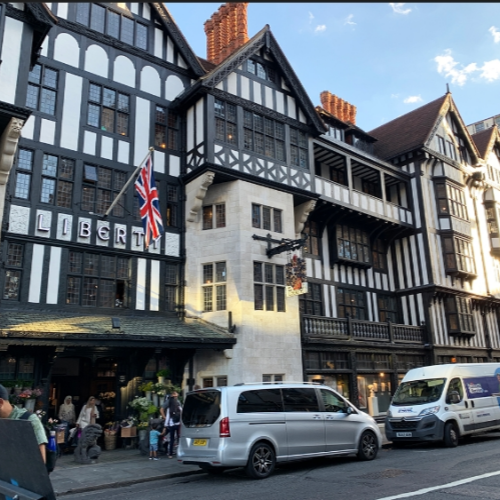Leave a Comment / Trends & Design, Pattern Design / By docsunhomeandliving
[Our Big Fame in Prints celebrates the legacy of the world’s most famous textile and print pioneers. This series delves into their business story, timeless designs, and enduring influence on global fashion, interiors, and cultural aesthetics.]
Author: Grace Pan
Date: 12 Dec 2024
I can still remember the first time I visited Liberty headquarter store in London at least 15 years ago. It was during Christmas time, its iconic Mock Tudor building with beautifully decorated Christmas windows stood out on Regent Street from distance. Inside, more charm was awaiting. The carved wooden stairs and balconies created a warm and inviting atmosphere, perfect for a traditional celebration of the season.

(Liberty & Co. headquarter store, London. Author took in 2022)
So, this is Liberty, the iconic British retailer and design house. It began its journey in 1875 as a small but ambitious enterprise that would grow to become synonymous with exquisite fabrics and artful prints.
The Beginnings of Liberty
Arthur Lasenby Liberty founded Liberty & Co. in London’s Regent Street in 1875. Initially, the store focused on importing luxurious goods from Asia, catering to a growing fascination with Eastern art and craftsmanship in Victorian England. Liberty’s eye for unique, high-quality products resonated with the tastes of his clientele, quickly establishing his store as a destination for discerning shoppers.
Arthur Liberty’s philosophy was clear: to create a store “fit for the artistic shopper.” The shop was designed with an aesthetic sensibility that blended perfectly with the goods it sold. Exotic silks, textiles, and homewares transported customers to far-off lands, tapping into a desire for opulence and adventure.

(Inside Liberty’s headquarter store. Author took in 2022)
Transition to Fabric Design
In the late 19th century, Liberty transitioned from importing textiles to creating its own fabric designs. Inspired by the artistic movements of the time, particularly the Arts and Crafts movement, Liberty collaborated with prominent designers like William Morris and Archibald Knox. These collaborations gave birth to innovative and elaborate prints that embodied the ideals of craftsmanship, artistry, and beauty.
By the early 20th century, Liberty had firmly established itself as a pioneer in textile design. The brand’s floral prints, delicate patterns, and harmonious colour palettes became its signature. The designs were not just beautiful but also versatile, making them popular among dressmakers and fashion houses alike.

The Liberty Print Phenomenon
What truly catapulted Liberty into the limelight was its introduction of the “Liberty Tana Lawn” fabric in the 1920s. Tana Lawn is a cotton that behaves like silk, named after the River Tana in East Africa, where the cotton for the fabric was sourced. This ultra-fine, smooth cotton was perfect for printing intricate designs, allowing Liberty to showcase its mastery of detail and colour.

Liberty’s prints became highly desirable, especially in the burgeoning fashion industry. Designers loved the fabrics for their quality, versatility, and unique artistic appeal. Over time, Liberty’s prints grew into a symbol of timeless elegance, gracing everything from haute couture to casual wear.

(Liberty prints in fashion accessories. Author took in 2022)
Here’s an overview of how Liberty prints have influenced fashion over the decades:
- Victorian-Era Aesthetic Revolution:
Liberty prints offered an alternative to industrial mass production, aligning with the Arts and Crafts Movement. This emphasis on handcrafted, nature-inspired patterns influenced British dressmaking and home sewing culture.
- Art Nouveau and Edwardian Elegance:
During the early 20th century, Liberty’s floral and abstract designs became synonymous with refined, modern elegance. Designers used Liberty fabrics to create Edwardian tea dresses and blouses that reflected the Art Nouveau aesthetic.
- Counterculture and Bohemian Fashion:
In the 1960s and 70s, Liberty prints became emblematic of the bohemian lifestyle. British designers like Mary Quant and Ossie Clark incorporated Liberty fabrics into their collections, popularizing their use in flowing, free-spirited designs. Liberty prints also became a favourite for home dressmakers, aligning with the DIY ethos of the era.
Liberty Today: A Timeless Legacy
Liberty’s history is a remarkable story of vision, creativity, and adaptability, earning it a place as a cherished name in the world of design and fashion.
The company continues to thrive as a leading name in textiles and fashion. Its archive holds thousands of prints, which designers frequently draw upon to create modern interpretations of classic designs.

(Accessories department in Liberty headquarter store. Author took in 2022)
From its roots as an importer of Asian goods to its status as a global design powerhouse, Liberty’s journey is a testament to the power of innovation, artistry, and a commitment to quality. The legacy of Liberty’s prints endures, inspiring both designers and wearers with its timeless beauty and enduring charm.
The story of Liberty is a source of inspiration—a reminder that true artistry never goes out of style.


